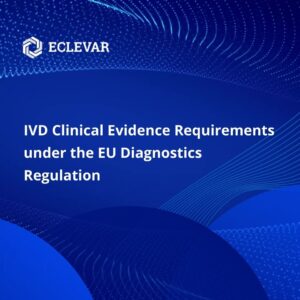What are the IVD Clinical Evidence Requirements under the EU Diagnostics Regulation?
Medical technologies in the European Union are subject to strict regulations. In order to legally market a medical technology within the Europe, manufacturers must comply with the requirements outlined in the applicable EU legislation, including get a CE mark to their product.
Since the 1990s, the regulation of in vitro diagnostic medical devices (IVDs) has been governed by the IVD Directive 98/79EC. However, as of May 2022, the In Vitro Diagnostic Medical Devices Regulation (EU) 2017/746 (IVDR) is entirely in effect.
To facilitate a smooth transition, most IVDs are granted a three to five-year period to follow the new regulations outlined in the IVDR. Over this transitional period, all IVDs will gradually shift their compliance to meet the requirements of the IVD Regulation. Get to know the IVD Clinical Evidence Requirements under EU Regulation.
Clinical Evidence
According to Article 56 of the IVDR, the components of clinical evidence for medical devices must align with the manufacturer’s intended purpose and involve a continuous process of performance evaluation.
The evaluation should follow a well-defined and methodologically sound procedure to demonstrate scientific validity, analytical performance, and clinical performance. The derived clinical evidence from the performance evaluation must be scientifically robust and demonstrate, in comparison to the current state of medical knowledge, that the device will achieve the intended clinical benefits, while should also provide valid assurance that the device fulfils the relevant general safety and performance requirements under normal conditions of use.
It is the manufacturer’s responsibility to provide clinical evidence. Manufacturers of IVD products must ensure that their devices achieve the performances specified. These performances encompass both analytical and clinical aspects.
Following the guidelines outlined in the IVDR, manufacturers are responsible for establishing and maintaining clinical evidence that supports the intended purpose of their medical devices continually throughout the market life of their device. The evaluation process and the follow-up pathway must be recorded in the initial plan.
Clinical Evidence Levels
In the context of In Vitro Diagnostic (IVD) devices, Clinical Evidence levels reflect different factors such as:
- Source of the evidence
- Statistical validity
- Clinical relevance
- Peer-review acceptance
These levels (from A to D) measure the strength, robustness, and quality of the evidence supporting the device’s safety and performance.
Regardless of the risk class, analytical performance and scientific validity evidence levels, , can be similar among IVD devices. However, an approach based on risk classification and intended purpose is recommended when considering clinical performance.
Documentation of Performance Evaluation requirements
Annex XIII of the IVDR provides a comprehensive framework for the requirements concerning the plans and reports on Performance Evaluation and Post-Market Performance Follow-up (PMPF). This framework outlines the systematic flow of plans and reports, specifying the needed frequency for updating each report.
The performance evaluation and accompanying documentation must be continuously updated throughout the device’s lifecycle, incorporating data obtained from the manufacturer’s PMPF plan as outlined in Part B of Annex XIII and the post-market surveillance plan mentioned in Article 79. The conclusions drawn from the performance evaluation report may prompt modifications to the device’s intended purpose or the performance evaluation plan itself.
Take a look at an overview of the required frequency of different documents depending on the device class below.
All classes:
- Performance evaluation and associated documentation – Must be updated throughout the entire device’s lifecycle
Classes A & B:
- Post Market Surveillance Report – Must be updated when necessary
Classes C & D:
- Periodic Safety Update Report (PSUR) – Must be updated at least once a year
- Performance Evaluation Report – Must be updated as necessary (at least annually)
- Summary of Safety and Performance (SSP) – Must be updated as soon as possible, where necessary
Summary of safety and performance
The new IVD Regulation mandates the creation of a Summary of Safety and Performance (SSP) specifically designed for class C and D devices to promote transparency and ensure adequate access to information. The primary objective of the SSP is to offer the general public, including professionals and laypersons, a concise overview of the safety and performance data related IVDs.
By providing this summarized data, the SSP aims to empower users with the necessary information to make informed decisions.
- MDCG templates for SSP are available, you can see them here: guidance MDCG 2022-9.
To comply with the regulatory requirements, the manufacturer is responsible for submitting a draft SSP along with the application documents to the Notified Body (NB) involved in the conformity assessment process, as outlined in Annex IX and X. The NB then undertakes the crucial task of verifying the SSP, ensuring that all essential elements are adequately addressed and that the information provided aligns with the technical documentation evaluated during the conformity assessment.
This verification process serves as a quality check to ensure that the SSP accurately represents the safety and performance characteristics of the device, enhancing transparency and reliability for all stakeholders involved.
Post-market Performance Follow-up
Post-Market Performance Follow-Up (PMPF) is an ongoing process that plays a crucial role in updating the performance evaluation, as outlined in Article 56 and Part A of Annex XIII and is specifically
addressed in the manufacturer’s post-market surveillance (PMS) plan. As part of PMPF, the manufacturer is responsible for actively gathering and assessing performance data and relevant scientific information derived from using a device bearing the CE marking, which is placed on the market or put into service within its intended purpose as defined in the applicable conformity assessment procedure.
By conducting PMPF, manufacturers can maintain a proactive approach to monitoring their devices’ performance in real-world settings. This process enables them to continuously evaluate and validate the safety and efficacy of their products, thereby ensuring their continued acceptability and adherence to regulatory standards.
The main objectives of the PMPF are:
- Ensure safety, performance and scientific validity throughout the entire device’s lifetime
- Access systematic misuse
- Access new safety problems
- Evaluate benefit/risk proportion
- Discover possible new risks
- Identify possible limitations to the device’s performance
Benefit-Risk Requirements & Potential Approaches under the IVDR
The concept of ‘benefit-risk’ entails conducting assessments of the benefits and risks associated with using a device for its intended purpose, as specified by the manufacturer. This analysis takes into account the potential benefits and risks of the device when used in accordance with the right instructions.
The clinical benefit of an IVD device focuses on the accuracy and reliability of the medical information it provides, aligning with the intended purpose and claimed performance as defined by the manufacturer, and in conjunction with other medical information. However, in some instances, the clinical benefit of an IVD device may be linked to the positive impact of the device’s results on patient management or public health.

